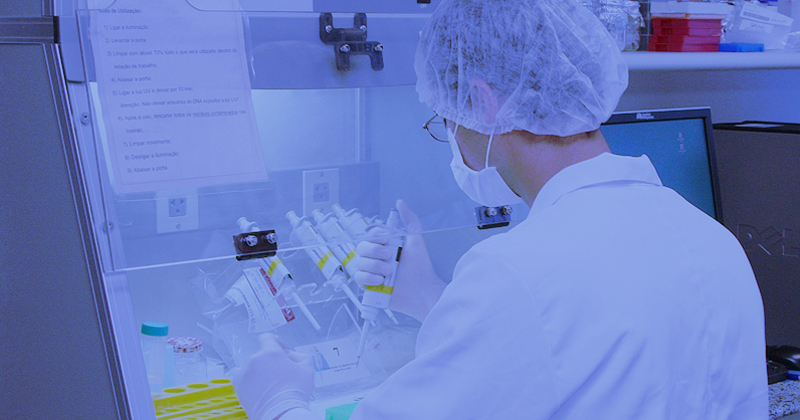
Scientists from USP’s Center for Research on Redox Processes in Biomedicine – Redoxome and its Institute of Bioscience (IB) are “treading” a path that may lead to the development of new medicines. In an article recently published in journal ACS Catalysis, they demonstrated how the Ohr enzyme (Organic Hydroperoxide Resistance Protein) is capable of protecting single-cell organisms such as bacteria from oxidation and lesions. “This enzyme makes it so that bacteria develop resistance against organic hydroperoxides, which oxidize its structure. Oxidation is the process that leads to the loss of electrons by a molecule (such as DNA, for example), altering its structure and many times leading to the loss of function. Thus, an antioxidant is a compound that protects cells against the action of oxidants. If we discover its entire functioning, we will be able to strike an ‘Achilles heel’ of bacteria”, observes professor Luis Netto, from the IB.
Netto says that, in this research, scientists were able to describe six crystallographic structures of the Ohr protein and analyzed the structural changes during its catalytic cycle. This work was carried out during the doctoral studies of Renato Mateus Domingos, who was advised by Netto and is the first author of article Substrate and product-assisted catalysis: molecular aspects behind structural switches along Organic Hydroperoxide Resistance Protein catalytic cycle. “The description of the structures of Ohr is like having the lock. What we lack now is the key to open this door”, describes the professor. When he refers to the key, it is nothing more than locating molecules capable of inhibiting Ohr and, with this, weaken the bacteria.
Netto also emphasizes that, since no enzymes similar to Ohr exist in mammals or plants, it becomes an attractive target for the development of medicines. “The identification of inhibitors of this protein would also be important for agriculture, insofar as the Ohr protein has already been found in pathogens – bacteria and fungi – that attack plants”, explains the researcher.
Ohr’s central role

Relations between pathogens and hosts are complex and were modulated during the evolutionary process. When invaded by pathogenic microorganisms (bacteria), plants and animals trigger an inflammatory response, with the generation of oxidants, among which are the hydroperoxides derived from fatty acids. Bacteria, in turn, “counterattack” with an arsenal of enzymes, among them Ohr, to decompose such oxidants. In this response, as Netto describes, Ohr is one of the enzymes that play a central role. For this reason, the enzyme has been associated with the virulence of several bacteria such as Pseudomonas aeruginosa (which causes pneumonia), Chromobacterium violaceum (an opportunistic pathogen that may cause abscesses in the liver, lung, and skin, as well as severe septicemias in humans), and Bacillus cereus (a notorious pathogenic food-borne bacteria that may produce diarrhea).
Superbugs, or multi-drug resistant microorganisms (MDR), are a world threat to public health. The World Health Organization (WHO) has been alerting that we may be headed towards a post-antibiotic era, in which common infections and light wounds may go back to killing. Hence, the identification of new targets for the development of antimicrobial treatments is of global urgency.
Model description
The description of Ohr’s structures also included the structure of the complex between the enzyme and its biological substrate, dihydrolipoamide (DHL). “We used various approaches, such as crystallography, computerized molecular dynamics, and kinetics to describe our model, with a focus on Ohr’s catalytic cycle reduction phase, which was the less known. The structure of the complex between the enzyme and its reducing substrate served as the basis for the modelings of theoretical simulation. By knowing the enzymatic mechanism, it is easier – or less difficult – to design inhibitors for Ohr”, describes Netto.
In the laboratories of the IB, scientists removed the Ohr enzyme from bacteria Chromobacterium violaceum and Pseudomonas aeruginosa (which causes pneumonia). More specifically, “the work consisted in the removal from the bacteria of the DNA that encodes these enzymes”, describes Netto.
The crystallographic structures were obtained using the infrastructure of laboratories that generate synchrotron light: the Synchrotron from Stanford University – Stanford Synchrotron Radiation Light source (SSRL) – and the Brazilian National Synchrotron Light Laboratory (LNLS) in Campinas.
The validation of such structures was done in collaboration with researchers Raphael D. Teixeira and Shaker Chuck Farah, from USP’s Chemistry Institute (IQ), and Plínio S. Vieira and Mario Murakami from the Brazilian Biosciences National Laboratory (LNBio) of the National Center for Research in Energy and Materials (CNPEM).
The article also brings the signatures of the following researchers: Raphael D. Teixeira (IQ), Ari Zeida and William A. Agudelo (Universidad de Buenos Aires, Argentina), Thiago G.P. Alegria (IB), José F. da Silva Neto (USP’s Ribeirão Preto School of Medicine), Plínio S. Vieira and Mario T. Murakami (LNBR), Shaker Chuck Farah (IQ), Dario A. Estrin (Universidad de Buenos Aires, Argentina), and Luis E.S. Netto (IB).
With information from Maria Célia Wider/Communications Advisory of Redoxome
More information: email nettoles@ib.usp.br, with professor Luís E.S. Netto
